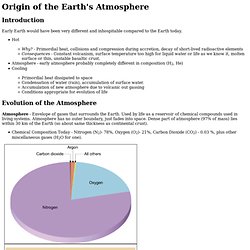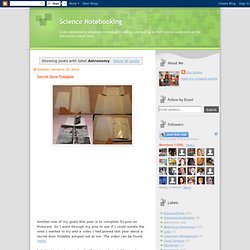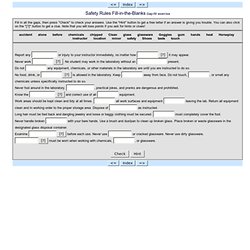

GeoGreeting! The atmosphere - origin and structure. Origin of the Earth's Atmosphere Introduction Early Earth would have been very different and inhospitable compared to the Earth today.

Hot Why? - Primordial heat, collisions and compression during accretion, decay of short-lived radioactive elements Consequences - Constant volcanism, surface temperature too high for liquid water or life as we know it, molten surface or thin, unstable basaltic crust. Atmosphere - early atmosphere probably completely different in composition (H2, He) Cooling Primordial heat dissipated to space Condensation of water (rain), accumulation of surface water.
Evolution of the Atmosphere Atmosphere - Envelope of gases that surrounds the Earth. (figure and table from Lutgens and Tarbuck, The Atmosphere, 8th edition) First Atmosphere Second Atmosphere Produced by volcanic out gassing. Addition of O2 to the Atmosphere Today, the atmosphere is ~21% free oxygen. During the Proterozoic the amount of free O2 in the atmosphere rose from 1 - 10 %. Biological Evidence. SMARTeKIDS Learning Web. Colorful Convection Currents at Steve Spangler Science. Fill two bottles with warm water from the tap and the other two bottles with cold water.

Use food coloring or the Fizzers coloring tablets to color the warm water yellow and the cold water blue. Each bottle must be filled to the brim with water. Hot over cold: Place the index card or old playing card over the mouth of one of the warm water bottles. Hold the card in place as you turn the bottle upside down and rest it on top of one of the cold water bottles. The bottles should be positioned so that they are mouth to mouth with the card separating the two liquids.
Earth's Atmosphere (7.2E.2) - Levering's Super Science. Mrs. Swofford - Atmosphere. Resources for Teaching About the Atmosphere. Mr. Crabtree's World. Astronomy. Whew...this week was one of those topsyturvy weeks that threw us off schedule slightly.

We had H1N1 shots administered Monday, a field trip Tuesday, no school on Wednesday.....looking forward to a "normal" week :) Monday - Showed students the International Year of Astronomy Trailer on YouTube and explained how 400 years ago Galileo used his telescope for the first time. Played the song "On the Shoulder of Giants" for students (video with the song can be found on my website - my students last year LOVED the song and had it memorized!). Showed a PowerPoint I made about the planets in order (had students line up as planets with smaller ones being the rocky inner planets and the taller students being the gas giants - threw some students in there to be the asteroid belt between Mars and Jupiter. I picked a student wearing red to be Mars and I lucked out with twins in one of my classes so I made them Venus and Earth).
Tuesday - No science classes due to field trip. Wednesday - No school. Safety Rules Fill-in-the-Blanks. Safety Rules Fill-in-the-Blanks Gap-fill exercise Fill in all the gaps, then press "Check" to check your answers.

Use the "Hint" button to get a free letter if an answer is giving you trouble. You can also click on the "[?] " button to get a clue. Accident alone before chemicals chipped Clean glass glassware Goggles gum hands heat Horseplay instructor location minor safety Shoes taste touch Report any or injury to your instructor immediately, no matter how it may appear.Never work .
The Biology Corner. NSDL.org - National Science Digital Library.